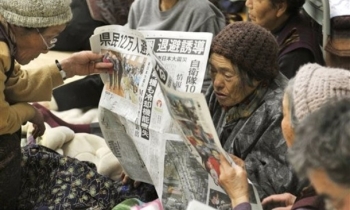Late last month, the Mumbai-based Chitralekha Group forged a unique alliance with the Maharashtra-centric Deshdoot group of publications. The Nashik and Shrirampur editions of the Marathi daily, Deshdoot, began carrying the weekly magazine, Chitralekha Marathi, on Sundays, virtually free of cost to the reader. Three weeks later, Chitralekha is poised to double its sales, claimedly, along with giving a big boost to a lagging Deshdoot. It may well be the country's first instance of a newspaper and a magazine joining hands. And not just for the advertiser, but also for the reader.
Readers of the Nashik and Shrirampur editions of Deshdoot were pleasantly surprised to find Chitralekha Marathi inserted in their Sunday newspaper of April 22, instead of the newspapers' Sunday supplement. Incidentally, the day also marked the 51st birthday of the Chitralekha Group. Nearly 45,000 copies of the two editions carried the 50-odd page Chitralekha Marathi. Selling otherwise at Rs 7 on newsstands, it came almost free to the reader. Sure, the newspaper's cover price was up by a rupee - from Rs 2.50 to Rs 3.50. It was supported by a massive promotion campaign in the two areas to drive circulation.
Beginning May 27, a similar exercise is being initiated in the remaining three editions of Deshdoot Marathi - Jalgaon, Dhule and Nandurbar. "We have increased sales in the last three weeks, and are already supplying 65,000 copies to the twin editions," claims Bharat Kapadia, managing editor and associate publisher, Chitralekha Group. Another 40,000-plus will be sold to Deshdoot for the three editions (31,000 for Jalgaon, 7,000 for Dhule and 4,000 for Nandurbar). In a total span of five weeks, Chitralekha stands to more than double its present circulation of 103,000 copies. Simultaneously, Deshdoot's combined circulation of nearly one-lakh copies (with five editions) is projected to double to two lakh, going by the response to the first two editions. "They have grown by more than 100 per cent in Nashik city," says Kapadia.
It sure sounds good for the reader. What about the advertiser? Unfortunately, the increase in circulation comes at a time when print advertising is going through a rather tough season. Observers cite April 2001 and the first half of May as being "rather bad". Kapadia, and his counterpart in Deshdoot, hope to convince advertisers not just on greater numbers but also on combined packages. "We are in the process of formalizing combined packages for the newspaper and the magazine," he says. "It will be a wonderful package to reach the entire Maharashtra in reasonable numbers," he reasons. The response from advertisers is awaited, as Kapadia and his team are only beginning to spread the message.
Another concerned party that has taken time to adjust to the new equation is the Nashik agent for Chitralekha Marathi. "He was very apprehensive," recalls Kapadia. "He had single-handedly built the market. But once we explained the returns, he is charged up." Kapadia has sold him the numbers spiel. Since he also sells Deshdoot, he gains to make money on higher volumes. (An agent makes 25 per cent on the cover price and a vendor gets 20 per cent). It may end up cannibalizing most of the magazine's newsstand sales though. Already, as Kapadia says, newsstand sales in Nashik have dropped from 6,000 to 4,000. But he is focussed more on the bigger gameplan. "Of course, we cannot allow uncontrolled growth in circulation," he affirms. "There are certain pockets that matter to advertisers and we have to stick by that."
A key question in understanding the new equation is the cost and pricing. How much money does Chitralekha make in the process and how does Deshdoot manage to sell it for almost one rupee? "The ABC allows a maximum of 40 per cent discount to the trade on the cover price," explains Kapadia. "If we had to increase our sales by other means, we would have ended up passing this discount in the market. So we sell the magazine to Deshdoot for Rs 4.20. They have discontinued their 16-page Sunday supplement, and hence, save substantial costs, and they have increased their cover price." But with the substantial increase in sales that both publications have seen, and continue to project, advertising revenues will need to be beefed up substantially.
The novel experiment is almost in line with another unique initiative launched by the Group two years back. The tenth anniversary Ganapati issue (which hit stands around Sep 1999), for instance, carried pouches of prasad' from Mumbai's famous Siddhivinayak Temple, along with a priest's certification and ceremony photographs. "But we needed more. When we analyzed the audience for Chitralekha Marathi," recalls Kapadia, "it was heavily concentrated in western Maharashtra. That is, Mumbai, Pune and Kolhapur." Running into his Deshdoot counterpart at an INS meeting last year, Kapadia suggested pooling of resources. "Deshdoot was the No 3 Marathi newspaper in Nashik, and they asked me how we made Chitralekha the No 1 Marathi weekly. We started discussing this in December and took four months to launch."
How well it succeeds on a long-term basis is another story. What gives Kapadia the kick, more than anything else, is the radical approach. "In today's market it is necessary to join hands and make one plus one equal to gyarah (11)," he says. "What often comes in the way are egos, or not crystallizing the issues enough. The good thing is that at least ideas have started floating around in the market."









